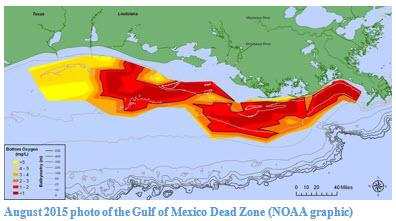WASHINGTON, Dec. 7, 2016 - Members of EPA’s Mississippi River/Gulf of Mexico Hypoxia Task Force, meeting Tuesday in New Orleans, heard from Louisiana state officials and a representative of the Louisiana Seafood Promotion and Marketing Board about the need to take action on the Gulf’s “dead zone.”
Chalin Delaune, vice president of wholesaler Tommy’s Seafood, told the HTF members that the “growing presence of hypoxia impacts the life cycle of our species and the catch efforts of our fishermen.” Recent years have seen “record low landings,” he said.
Hypoxic waters are areas with low oxygen—typically, less than 2-3 parts per million of dissolved oxygen. “Hypoxia can be caused by a variety of factors, including excess nutrients, primarily nitrogen and phosphorus, and waterbody stratification (layering) due to saline or temperature gradients,” according to HTF’s web site.
Earlier this year, scientists said they expected the hypoxic, or “dead” zone in the Gulf to cover almost 6,000 square miles, (about the size of Connecticut), forcing commercial fishermen to spend more time to land their reduced catch, he said.
“They’re having to stay longer at sea and spend more fuel to catch the same amount of product, or really, a lot less,” Delaune said.
“If we don’t hit our projections, if our goals aren’t met on time, it might cost us our fisheries,” he told the HTF members.
HTF’s work is cut out for them. In 2008, the task force said it wanted to reduce the dead zone to 5,000 square kilometers by 2015. At the end of 2014, however, it extended its deadline to reach that goal by 20 years, including a target of a 20 percent reduction in nitrogen and phosphorus loading by 2025.
 In that vein, the
task force heard about efforts to help farmers reduce their nitrogen and
phosphorus applications, including the Tulane Nitrogen Reduction Challenge,
which will award a $1 million cash prize to the team that “presents the best
solution to combat hypoxia,” Tulane University said in a news release announcing five finalists for the award. They
are: ADAPT-N of Ithaca, New York; AgDNA of Australia; Cropsmith of Farmer City,
Illinois; PIVOT of Berkeley, California, and Stable’N of Carmi, Illinois.
In that vein, the
task force heard about efforts to help farmers reduce their nitrogen and
phosphorus applications, including the Tulane Nitrogen Reduction Challenge,
which will award a $1 million cash prize to the team that “presents the best
solution to combat hypoxia,” Tulane University said in a news release announcing five finalists for the award. They
are: ADAPT-N of Ithaca, New York; AgDNA of Australia; Cropsmith of Farmer City,
Illinois; PIVOT of Berkeley, California, and Stable’N of Carmi, Illinois.
Solutions presented by the finalists to combat dead zones range from using electricity to inhibit nitrogen loss, utilizing microbes to enhance availability of nitrogen for crops, an integrated nutrient management system, and using real-time data and simulation scenarios through precision agriculture/model derivatives to determine nitrogen application rates, Tulane said.
The five teams now move into the in-field phase of the challenge. They will each have five acres of farmland in Tensas Parish in northeast Louisiana to field-test their innovation. “The winning team will be judged based on the impact their solution has on crop yield, how well their solution manages nutrient runoff and how much it costs,” Tulane said.
The Midwest Row Crop Collaborative also gave a presentation. MRCC members include PepsiCo, Environmental Defense Fund, Monsanto, the World Wildlife Fund, General Mills, The Nature Conservancy, Cargill, Walmart, and Kellogg’s.
MRCC is partnering with the National Corn Growers Association’s Soil Health Partnership (SHP) to accelerate the enrollment of 35 demonstration farms in MRCC priority watersheds throughout the Midwest. They are also working to develop case studies to help speed adoption of best practices, coordinate and leverage nutrient stewardship programs, and connect SHP communications and outreach, including case studies, to MRCC engagement with the ag retail sector. Some of the presentations from the meeting are online.
MRCC also is working with the Agricultural Retailers Association and Field to Market on a Sustainable Ag Resource Center, which would provide information online, as well as training for ag retailers and crop advisers.
A recent report from a coalition of environmental and legal advocacy groups criticized the Environmental Protection Agency for not using its Clean Water Act authority to force states in the Mississippi River Basin to develop numeric water quality criteria.
#30
For more news, go to: www.Agri-Pulse.com

